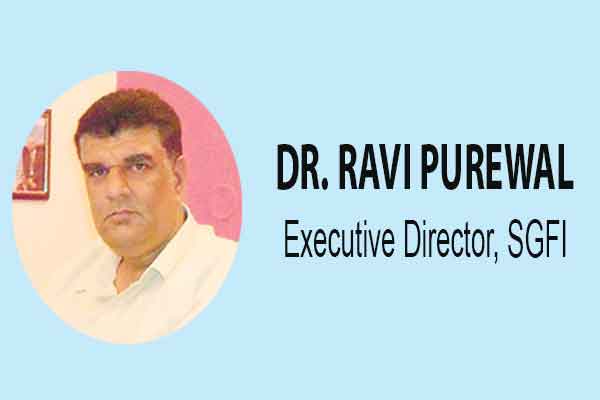FIFA allowed Sports Goods Foundation of India(SGFI) members to produce Soccer balls for FIFA Quality Concept Licensees under section 4.6.2 of the WFSGI pledge for the FIFA quality program.In order to comprehend more about the foundation and its innovative steps taken for the society at large, Dr. Ravi Purewal, Executive Director of the SGFI talks to Sportz Business and shared his insights.
Q. How SGFI does educate sports goods manufacturers and exporters to prevent and rehabilitate child labor?
Here is the misconception, people think that the manufacturer/exporter is using child labour. There is absolutely no person below 18 years of age who is working in the factory. The contractor takes the material for stitching from the factories and gives it out to the households where children might be involved in stitching. SGFI monitors such households. SGFI educates the general public, households, village heads etc. to not to use child labour. This is done on a regular basis since the last 21 years of existence of SGFI.
Q. Who are the major members present in your contemporary SGFI’s list of sports goods manufacturers and exporters? Here i am asking about those executive bodies who are actively involved in the activities of SGFI.
The executive bodies who are actively involved in the activities of SGFI are: (a). Department of Labour, (b) Punjab Govt, NCLP – Ministry of Labour& Employment – Central Govt, (c) World Federation of the Sporting Goods Industry (WFSGI), (d) FIFA, (e) Life Insurance Corporation (LIC), (f) Foundation of MSME Clusters (Ex-UNIDO), (g) Brands who are sourcing from SGFI members. (h) Central Leather Research Institute (CLRI), (i) Universities.
Q. How smooth SGFI gets its relationship with international bodies like UNICEF, FIFA, WFSGI and other reputed bodies?
In the beginning when we started, we did get a lot of technical help from UNICEF, SCF, WFSGI & FIFA, ILO, Govt. of India. FIFA actually funded $ 1,00,000 each for 4 years to start the monitoring program which was done by SGS. After which the industry decided to fund the program and is doing it till date.
Our monitoring reports are being sent to FIFA & WFSGI regularly. FIFA has also allowed SGFI members to produce Soccer balls for FIFA Quality Concept Licensees under section 4.6.2 of the WFSGI pledge for the FIFA quality program. UNIDO joined hands with SGFI in 2005 under its Cluster Development Program (CDP) to work on CSR related issues for the household stitchers and their families.
Due to which SGFI started programs in micro insurance through LIC, women empowerment by making Self Help Groups (SHG), micro finance, medical and health related issues, computer education for adults at different villages, tuition centers for children of football stitchers at different parts of the city where concentration of football stitchers is high. SGFI’s contract with UNIDO expired in 2008 after 3 years, thereafter SGFI continued with all the CSR related projects and are still doing it till date.
Q. Jalandhar being the sports goods capital of India, how do you see the current trend of the market?
SGFI is primarily concerned about the hand stitched inflatable balls, the export figures for 2018-19 are at Rs. 177 cr which has been increasing over the years. But the domestic sales figures are higher. Earlier the industry had shifted to machine stitched balls, moulded balls, thermo bonded balls but the foreign buyers are slowly shifting back to hand stitched balls. Apparently, machine stitched balls will continue for low quality but for PU and other high quality balls hand stitched will remain. Other than this the industry is also seeing a large volume in sales of fitness equipment and adventure sports as more and more people are becoming health conscious and moving away from traditional sports..
Q. What kinds of assistance did SGFI get meeting its sole objective of preventing child labor?
After inception of SGFI, we got a lot of technical assistance from SCF, UNICEF, ILO guidelines. FIFA, WFSGI, Brands & the local labour department. The sporting goods industry joined hands on this common platform to prevent child labour. SGFI members started to contribute voluntarily every month a percentage of its exports. SGS was hired by FIFA for a period of 4 years to initially conduct the monitoring program of child labour.
Q. How do you see Khelo India being introduced by the incumbent government to make any difference in your objective?
A fit and healthy individual leads to an equally healthy society and a strong nation. It is better to have 5 stadiums here rather than having 10 hospitals. Sports is an extremely important component for the development of our nation. India, in the last few years has made a steady progress in the field of sports but we need to give the young talent top-notch infrastructure and training of the highest level. The Khelo India program had been introduced to revive the sports culture in India at the grass root level by building a strong framework for all sports played in our country and establish India as a great sporting nation. There are various sporting clubs opened in and around Jalandhar who are working towards this objective.
SGFI has a very crucial role to play in this, in the sense that it is important to let the youth of today know that the products they are using meet with the Khelo India call.
Q. How far do you think, SGFI accomplished to attain its sole objective of preventing child labor?
In over 22 years of SGFI’s existence, a great amount of awareness has been generated amongst the stitching community & other stake holders to not to use child labour. Infact SGFI received the “Special Award” in 2010 for CSR by The Energy Resource Institute (TERI) and HSBC Bank called HSBC Living Business SME Award for its activities. IIM-B did an extensive case study on SGFI projects and this case study is being taught at over 500+ B-Schools. Over the years the number of cases of child labour have fallen drastically, in 2018-19 there were only 17 cases of child labour and they have been rehabilitated since. 90 % of the child labour cases found are those of migrant labour than the local Punjabi labour here.
Q. Tell our audience about the special schools that the SGFI opened for under privileged kids of stitching?
In 2004, the National Child Labour Project (NCLP) was started by the central govt. NCLP project is being run in 14 states, Punjab is one of them and in Punjab it is run in 3 cities (Ludhiana, Jalandhar and Amritsar). In Jalandhar the survey conducted by the local labour department found that there were 1350 children involved in child labour in various forms and industries, so it was decided to open up 27 NCLP schools with 50 children in each school. In each NCLP school children are given free education, books, midday meals and monthly stipend. As per the project none of these schools were to be run by the govt. but instead to given out to NGO’s. SGFI was given 4 of these schools under its’ management. After 3 years, looking at the performance of the schools under SGFI, the govt gave us 2 more schools, thus a total of 6 NCLP schools are under SGFI management currently.
Q. How effective was SGS monitoring of child labor in Jalandhar and what was the outcome of the report?
SGS specially set up an office in Jalandhar in 2000 and hired the local people as external monitors, they devised the monitoring program wherein each SGFI member was to give a list of all his locations where footballs were being stitched. Such reports were called Internal monitoring reports (IMR) which were given to SGS regularly by SGFI members. SGS on the other hand started their external monitoring to identify the child labour involved in those households and they would conduct monthly meetings with SGFI members telling us the outcome of their external monitoring. SGS was entrusted to only do the external monitoring and not to rehabilitate the child labour found. At the beginning when SGS started a lot of child labour cases were found, but with time and awareness created by SGFI, the number of child labour cases started coming down. The monitoring program was the first of its’ kind in India and as such it let the SGFI members know exactly where their footballs are being stitched, prior to this none of the manufacturers knew anything about it.
For more info: Click here
Disclaimer:
The information contained in this article is for educational and informational purposes only and is not intended as a health advice. We would ask you to consult a qualified professional or medical expert to gain additional knowledge before you choose to consume any product or perform any exercise.






